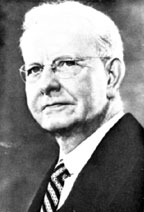
Image from Defries, First Forty Years, p. 323 |
Dr. Robert Davies Defries (1889-1975): Canada’s "Mr. Public Health" By Christopher J. Rutty, Ph.D. Originally published (without images) in:
|

Image from Defries, First Forty Years, p. 323 |
Dr. Robert Davies Defries (1889-1975): Canada’s "Mr. Public Health" By Christopher J. Rutty, Ph.D. Originally published (without images) in:
|
| During the first half of the twentieth century, Dr.
Robert Davies Defries played a central role in the development of public health in Canada. He possessed a rare combination of scientific knowledge, keen judgment, organizational, administrative and teaching skills, along with the ability to provide leadership and inspiration to those around him. At the same time Defries remained tireless and kindly, with a deep religious commitment, a quiet sense of humor and a complete dislike of ostentation. He had an encyclopaedic knowledge of applied bacteriology, epidemiology, immunology and public health administration, all of which were efficiently tapped during his long service with the University of Toronto’s Connaught
Medical Research Laboratories and the intimately connected School of
Hygiene, especially while Director of both institutions between 1940 and
1955.
From seeds planted in 1913, "Dr. Bob," as he was affectionately called, became the primary architect of, and was personally inseparable from, these internationally renowned institutions, particularly Connaught, and its unique public health mission: medical research, non-commercial production and distribution of essential biological products, and public service. Under Defries’ leadership, Connaught played a key role in the international control of numerous infectious diseases, especially through its pioneering development of methods for the large-scale production of such essential products as insulin, heparin, penicillin, combined antigens and both types of polio vaccines. Moreover, Connaught’s unique university structure and close links to the federal and provincial governments, reinforced by Defries’ professional and personal relationships, ensured that the public health benefits of Connaught’s many products were kept within the reach of everyone. Robert D. Defries (R.D.D.) was born in Toronto, Ontario, on July 23,
1889. His family’s Canadian roots extend back to 1829 when his great
grandfather arrived from England and later began a brewery in Toronto’s
east end. R.D.D.’s grandfather expanded the family’s business, operating
five of the city’s thirteen breweries in 1885. His father, William
Thomas, carried on with the business until his untimely death at age twenty-eight.
His mother, Agnes (Lumsden), who was deeply religious, was determined that
her two sons stay out of the brewery business and go to university.
She was successful and both Robert and his brother William attended the
University of Toronto and graduated in medicine. R.D.D. graduated
in 1911 with his M.B., followed by an M.D. in 1913 and a Diploma in Public
Health (D.P.H.) in 1914. Indeed, Defries was the first candidate
and first graduate of the D.P.H. program, a situation that developed fortuitously
and with some resistance, but which had enormous implications for the subsequent
evolution of public health in Canada.
|
| Public health education in Toronto began in 1875 with undergraduate
instruction in sanitary science at the Toronto School of Medicine, a forerunner
of the University of Toronto’s faculty of medicine that amalgamated in
1903. In 1910 a new Professor of Hygiene was appointed, Dr. John
A. Amyot (1867-1940), who was also Director of the Provincial Board of
Health Laboratory. Efforts to introduce graduate education in public
health by offering a D.P.H. at the University of Toronto had been initiated
as early as 1901, but the diploma was not offered until 1904, and not granted
until 1911. Only physicians were eligible, but it only involved passing
one examination with no formal course work.
A more structured D.P.H. program with specific courses was initiated in 1912 with the appointment of Dr. John W.S. McCullough (1868-1941) as Ontario’s Provincial Health Officer, who was interested in improving local health services across the province. However, he needed more qualified health officers and he turned to Amyot for help. Initially, the University of Toronto was reluctant to establish a formal D.P.H. graduate course. However, this situation changed when the young Defries, after a year of postgraduate study in biochemistry and hopeful of engaging in public health work, approached Amyot to apply for a postgraduate course at Toronto. With a qualified and enthusiastic candidate in hand, Amyot finally convinced the faculty of medicine to establish a new D.P.H. course and Defries was the sole student for the first academic session of 1912-13. The curriculum Defries studied was based on the British model that emphasized
sanitation, quarantine, ventilation and the clinical study of fevers, supplemented
by studies in geology, microbiology, meteorology and an apprentice course
in bacteriology in the Provincial Board of Health laboratory. In
1913, after graduating from this course, Defries was appointed as a demonstrator
for the D.P.H. course and was joined by Dr. John G. FitzGerald (1882-1940).
|

Medical Building,
|
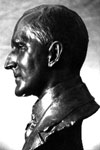
Dr. John Gerald FitzGerald
|
From this point, Defries and FitzGerald worked closely together to
establish what would become Connaught
Laboratories in 1913-14, while at the same time overseeing the growth
of the Department of Hygiene and Preventive Medicine and its transformation
into the School of Hygiene in 1927. FitzGerald and Defries were a
unique and complementary team: the former an inspired, and even a reckless
public health visionary, the latter a eminently practical medical missionary
and prudent administrator able to render FitzGerald’s ideas into a sustainable
structure. Still, FitzGerald had to convince Defries early on to
forego a real medical missionary calling.
The unique vision of an institution devoted to medical research and the non-commercial production of essential health products within an university environment originated with FitzGerald. It emerged out of a long period of education and travel driven by a strong desire to practically develop and apply the latest methods of preventive medicine at the lowest possible cost and for the largest public benefit. FitzGerald, though born in Ontario, came from Irish stock and graduated from the University of Toronto with a medical degree in 1903. For the next five years FitzGerald’s studied psychiatry in the U.S. and Toronto, which proved ironic in light of his later mental illness and breakdown in the late 1930s and tragic suicide in June 1940. A new passion for bacteriology soon emerged, leading FitzGerald back to Toronto to teach it between 1909 and 1911. FitzGerald’s direction into preventive medicine intensified during the summers of 1910 and 1911 when he studied in Europe at the Pasteur and the Lister Institutes. He also became aware of efforts in Boston and New York, where, under city or state auspices, laboratories for the production of public health products had been established to great public benefit. In 1913, FitzGerald was invited back to Toronto where he hoped to practically apply the benefits of what he had seen elsewhere to Canada, but within a university environment. FitzGerald’s first opportunity emerged in the summer of 1913 when he prepared the Pasteur Rabies Treatment in the Ontario Board of Health laboratory. Hitherto, this product was imported from New York at a much greater cost. Fitzgerald then presented his vision for a university-based laboratory for biologicals production and research but encountered resistance from the University governors, who were concerned that such an enterprise involved commerce more than academics. However, FitzGerald was keenly aware of the tragic toll of diphtheria in Canada and a complete reliance on diphtheria antitoxin imported from U.S. commercial suppliers at a price that made it’s benefits available only to the well-to-do. Undaunted by the university’s hesitancy, though confident of its ultimate
support, FitzGerald, using his own money, went ahead and built a stable,
and bought horses and laboratory equipment to begin production of diphtheria
antitoxin. Within a few months he had won his first contract to produce
the life-saving antitoxin for the Ontario Board of Health for free provincial
distribution; he produced it at one-fifth to one-tenth the cost charged
by American producers. Finally, recognizing the obvious public-service
benefits, on May 1, 1914, the University of Toronto assumed full financial
responsibility for FitzGerald’s work, gave him laboratory space and appointed
him Director of this new Antitoxin Laboratory in the Department of Hygiene.
Despite some early opposition from commercial manufacturers and druggists,
by 1920 all provinces were freely distributing Connaught’s products.
|
| The outbreak of World War I at first threatened the survival of this
fledgling laboratory, but soon generated the national interest necessary
to ensure its rapid growth. Defries played a key role in this process
through the expedited production of tetanus antitoxin that was urgently
needed by the Canadian Expeditionary Forces. The Canadian Red Cross
tried to purchase the antitoxin in the United States but supplies were
limited and each dose cost $1.35.
The savior of FitzGerald’s vision was Colonel Albert E. Gooderham (1861-1935), a wealthy Toronto distiller, who served on the Canadian Red Cross Executive Committee and was a University of Toronto Governor. Prompted by the federal government, Gooderham approached FitzGerald to prepare the tetanus antitoxin, but the capacity of the new Antitoxin Laboratory was thought insufficient to meet the growing demand for it as well as other essential health products. Nevertheless, beginning in February 1915, tetanus antitoxin production was stepped up under Defries’ personal direction and was made available to the army at $0.34 a dose. In total some 250,000 doses were manufactured during the war, meeting all the Canadian military needs. Gooderham’s most important legacy came in 1915 with his gift of a 57-acre
farm property that would include a modern laboratory building. These
new facilities were officially opened on October 25, 1917, and, by request
of Gooderham, were christened the "Connaught Antitoxin Laboratories and
University Farm," after the Duke of Connaught, Canada’s Governor-General
during the war. The Ontario government matched Gooderham’s gift with
a grant of $75,000 to support medical research. To ensure a national
character for Connaught, FitzGerald set up an Advisory Committee on Scientific
Work with representatives from each province. In 1920, soon after
the establishment of the Department of National Health, a more formal "Dominion
Council of Health" first met and was composed of the federal and provincial
deputy ministers of health and five other members, including FitzGerald,
and then Defries (who served between 1940 and 1962), affording a regular
national forum in which the work of Connaught was integrated into provincial
and federal health programs.
|

Original Connaught Antitoxin Laboratories
|
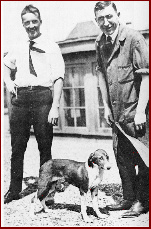
Dr. Frederick G. Banting &
|
Connaught’s practical value to public health became especially prominent
with the discovery of insulin at the University of Toronto in 1921-22.
This story is well known (Bliss,
1982), but less appreciated is Connaught’s pioneering role, largely
under Defries’ direction, in developing methods to produce insulin on a
large scale and at the lowest possible cost to diabetics. Defries
also played a critical role in securing a patent for the University of
Toronto to ensure high international production standards and the direction
of insulin proceeds to the expansion of medical research across Canada.
Defries also worked closely and unselfishly with the discoverers of insulin,
as well as Eli Lilly and Company, to ensure expanded production.
This cooperative approach was also the case with other essential products
Connaught helped develop on a large scale; including heparin, protamine
zinc insulin, penicillin, typhus vaccine, combined antigens, and the Salk
polio vaccine.
Insulin was the most significant product to Connaught’s financial health and physical growth until the development of polio vaccines. Moreover, "the discovery of Insulin was a stimulus of first importance" to the establishment of the School of Hygiene and its endowment by the Rockefeller Foundation (Defries, July 1957: 289). In addition to being Associate Director of the School until 1940, Defries was also head of the Department of Epidemiology and Biometrics, and later the Department of Public Health Administration. The new School of Hygiene building provided a centre for public health teaching, expanded facilities for Connaught and an administrative focus for both institutions. This building also served as the heart of the Canadian Public Health Association, founded in 1910, and its journal, especially when Defries became its editor in 1928; a position he held until 1964. Defries was the backbone of the C.P.H.A. and is widely credited with re-energizing its journal. World War II placed heavy demands on Connaught and resulted in a major
period of expansion in staff and capacity. In addition to supplying
the military with tetanus and gas gangrene toxoids and a new typhus fever
vaccine developed by Connaught, the war placed the greatest demands on
Defries’ administrative skills to produce dried human blood serum to treat
shock among soldiers. This work required additional space and in
1943 Defries expedited Connaught’s acquisition of a large building on campus
that became the Spadina Division.
At the same time, the new Division was also urgently required to develop
methods to produce penicillin on a large scale for the federal government
in time for D-Day in June 1944.
|
| During the post-war years Defries led Connaught through a period of
accelerated expansion, driven largely through cancer and virus research,
and was financed most significantly by Federal Public Health Research Grants,
and the National Foundation for Infantile Paralysis (NFIP) or U.S. March
of Dimes. While Connaught conducted research in many fields, its
comprehensive polio research program, which began in 1947 under the direction
of Dr. Andrew J. Rhodes (1911-1995), paid the greatest scientific, public
health and political dividends. Through Defries’ direct leadership,
Connaught developed the methods that proved essential to the large scale
production of Salk’s inactivated polio vaccine.
The first step was Connaught’s development of the world’s first synthetic medium, known as "Medium 199," for cancer research by J.F. Morgan, H.J. Morton and R.C. Parker in 1949. In 1951, through a close friendship between Morgan and Dr. A.E. Franklin of Rhodes’ group, Franklin discovered that "199" proved ideal for cleanly culturing the poliovirus in monkey kidney cells. This made Salk’s vaccine safe for the first human clinical trials in 1952. The NFIP then financed a major pilot project at Connaught to cultivate the poliovirus in larger quantities. In 1953, this effort led to the "Toronto Method," developed by Dr. Leone N. Farrell (1904-1986), which involved culturing the poliovirus in a suspension of monkey kidney cells in "199" using large bottles incubated on special rocking machines. Salk’s vaccine could now be produced in enough quantities to vaccinate every child. In July 1953, as Defries took direct control of the polio work, the NFIP asked Connaught to carry out what Salk called the "herculean" task of supplying all the bulk poliovirus fluids that was inactivated in the U.S. for the 1954 field trial. Despite some reservations within the University, over the speed of the trial and the safety of the vaccine, Defries efficiently and quietly carried out this "unusual" project. Soon after the NFIP field trial began in April, Defries turned his attention to preparing a finished vaccine supply for Canadians and planning for its introduction in light of its still unknown value. Gambling the vaccine was safe and at least somewhat effective, in October 1954, the Dominion Council of Health agreed to Defries’ plan for the national use of the vaccine on an experimental basis, regardless of the U.S. trial results. The cost of the vaccine was to be shared equally between the federal and provincial governments, ensuring free vaccinations for some 500,000 children across Canada. The start of this Canadian program coincided with the much anticipated April 12, 1955 announcement of the NFIP field trial results in Ann Arbor, Michigan, which revealed that the vaccine was safe and 60-90% effective. However, high public expectations and unprecedented media coverage generated the popular perception that the vaccine was completely successful and that the long war against polio was finally over. This attitude was particularly strong in the American press and it worried Defries. Dr. G.D.W. Cameron (1899-1983), Deputy Minister of National Health, who, with Defries, sat well toward the back of the room at the Ann Arbor event, was more concerned that "throughout the performance there was no recognition of what the Connaught had done." He later remembered "being furious but Bob, of course, was philosophical" (Rutty, 1995: 345). Canada’s foresight in planning early for the vaccine’s orderly introduction,
orchestrated largely through Defries’ leadership, was prominently vindicated
in the wake of the infamous "Cutter Incident." By early May 1955,
some 80 cases of paralytic polio in the U.S. were directly associated with
vaccine prepared by Cutter Laboratories of California, touching off a national
crisis that resulted in the cancellation of the entire U.S. vaccination
program. In Ottawa, Paul Martin, the Minister of National Health
and Welfare, faced one of his most difficult political decisions: what
should Canada do? The Prime Minister was reluctant to let the Canadian
trial continue, but based on Defries’ convincing counsel and the experience
of Connaught with the development of the vaccine, Martin maintained his
confidence. The vaccine had not yet caused any problems in Canada
and so the immunization program continued without incident. Martin’s
confidence was also based on a stricter Canadian testing procedure in which
Connaught and the federal Laboratory of Hygiene tested each vaccine lot;
something which lapsed in the U.S. when commercial manufacturers expedited
the release of the vaccine immediately after its licensing. This
unusual Canadian success story generated significant American media attention
and political debate, sharply highlighting the differing levels of government
interest in controlling the vaccine. The prominence of the Canadian
Salk vaccine program also played a major role in ensuring its future international
use in the control of polio.
|
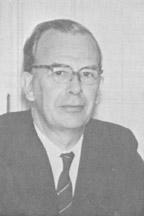 Dr. Andrew J. Rhodes
|
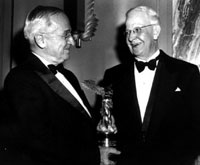
Dr. R.D. Defries receiving the
|
The Salk vaccine introduction was Defries’ swan song. He retired
as Director of Connaught and the School of Hygiene on September 30, 1955.
On November 17, Defries was the 1955 recipient of the presti-gious Albert
Lasker Award from the American Public Health Association. He was
the first Canadian so honored. While the award was given in recognition
of Defries’ polio vaccine leadership and his distinguished carrer in Canadian
and U.S. public health, the award was expedited by an American-led "effort
to make up for the omission at Ann Arbor" (Rutty,
1995: 358-9).
After his retirement, Defries remained as Director Emeritus and Consultant for Connaught, actively supporting his successor, Dr. J.K.W. Ferguson (1907-1999), expand production of the Salk vaccine, prepare combined antigens containing polio vaccine in 1958-59, and develop the first trivalent Sabin oral polio vaccine between 1959 and 1962. Defries also worked closely with his successor at the School, A.J. Rhodes, who faced perhaps the greater challenge of maintaining the public health mission of the School in the shadow of a rapidly expanding Faculty of Medicine. In recognition of his enormous legacy, in 1965 the Canadian Public Health Association established the "R.D. Defries Award" to honour outstanding individual contributions to public health. In his retirement years Defries received many other honours, including the Companion of the Order of Canada in 1970, which as Ferguson recalls, he was characteristically reluctant to accept. As noted earlier, Defries’ personal life was inseparable from his work. He never married and in his spare moments, in addition to a passion for flowers and photography, he paid close attention to helping others, particularly employees, to find worthwhile tasks that suited their talents. Defries was also the first official historian of Connaught and he spent much of his retirement preparing a history of the laboratories, published in 1968. Robert D. Defries, "Canada’s Mr. Public Health," died quietly at his
home on October 25, 1975, leaving an indelible impact on Canadian public
health through his writings and which continues today through the institution
he largely created, Connaught
Laboratories. Connaught was sold by the University of Toronto
in 1972 and has since been transformed into the North American component
of the world’s largest fully integrated biologicals company, Pasteur Mérieux-Connaught
of France. Defries’ medical missionary spirit still resides in Connaught’s
essential public health research and production work that continues into
the twenty-first century much as it did under Defries’ direction during
much of the twentieth, quietly protecting the public from the tragedy of
infectious disease.
|
| REFERENCES:
Information pertaining to Defries is held in the Archives of Sanofi Pasteur Limited (Connaught Campus), 1755 Steeles Ave. W, North York, Ontario. The collection contains numerous medical journal and newspaper articles correspondence and reprints of Defries’ articles and a personal papers file. Also important are Defries’ Connaught and School of Hygiene Annual Reports of the Director (formally published after 1948). The Archives of the University of Toronto and the National Archives of Canada in Ottawa (RG29) also contain some of Defries’ correspondence. Dr. J.K.W. Ferguson, Defries’ successor as Director of Connaught (1955-1972), was another important source of information on Defries’ life. I thank Dr. Ferguson for his kind assistance. Very little secondary material has been written on the life and work of Dr. Defries. The most significant sources are Bator (1990, 1995) and Rutty (1995). Abbreviations: CPHJ = Canadian Public Health Journal Writings by Defries:
Known as Connaught Laboratories during most of the 1920s through 1940s, and as Connaught Medical Research Laboratories after 1946, the Labs remained an uniquely organized, non-commercial and self-sustaining part of the University of Toronto from 1914 until 1972, when it was sold to the Canadian Development Corporation (CDC), a federal Crown corporation, and privatized. By 1989 the CDC had divested much of its interest in Connaught and Institut Merieux of Lyon, France, acquired a controlling stake in the company. By this time, Institut Mérieux had formed an alliance with the Pasteur Institute. Over the next decade Connaught remained the Canadian component of what became known as Pasteur Merieux Connaught, which, in turn, was owned by Rhone Poulenc, a French multinational chemical, agricultural and biotech company. In December 1999, Rhône Poulenc and the German pharmaceutical and chemical company, Hoechst, joined forces to create a new pharmaceutical/ biotech giant known as Aventis. In the process, Connaught's identity changed in a significant way for the third time since 1972. Pasteur Mérieux Connaught became known as Aventis Pasteur, and in Canada became the "Connaught Campus" of Aventis Pasteur. However, within five years, Aventis was transformed into the even larger Sanofi-Aventis Group, following the acquisition of Aventis by Sanofi-Synthelabo of Paris. The original Connaught identity thus shifted yet again to become the Canadian component of Sanofi Pasteur, the global vaccine business of Sanofi-Aventis. For more see the Canadian History section of sanofipasteur.ca
|